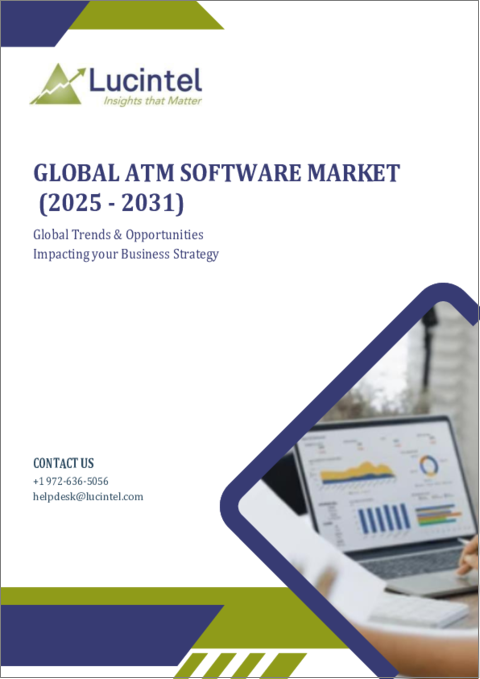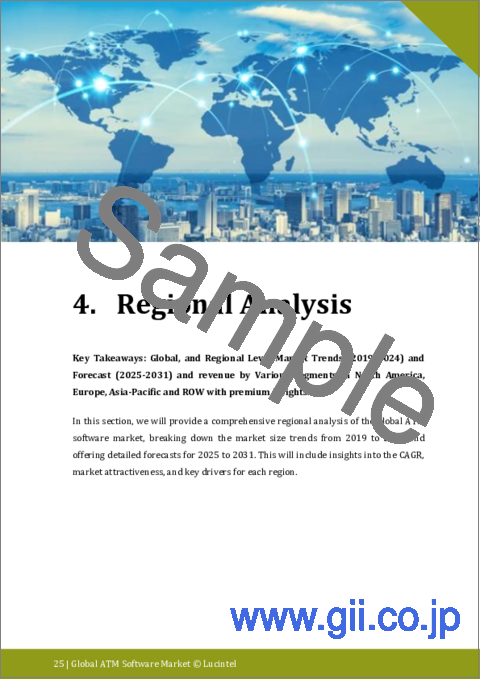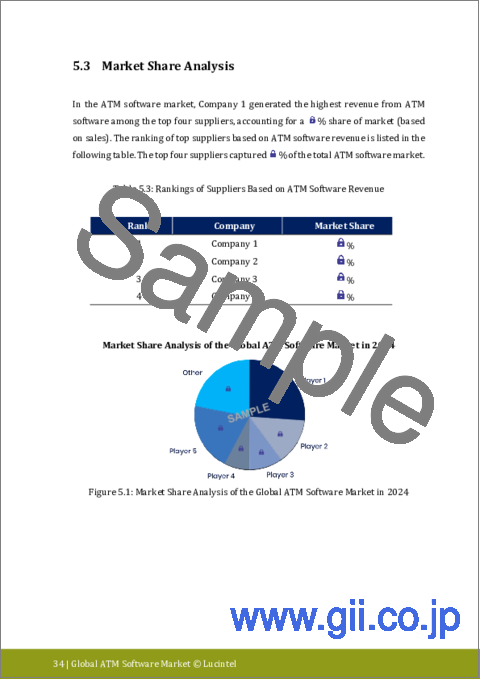|
|
市場調査レポート
商品コード
1749187
ATMソフトウェア市場レポート:2031年までの動向、予測、競合分析ATM Software Market Report: Trends, Forecast and Competitive Analysis to 2031 |
||||||
カスタマイズ可能
適宜更新あり
|
|||||||
| ATMソフトウェア市場レポート:2031年までの動向、予測、競合分析 |
|
出版日: 2025年06月13日
発行: Lucintel
ページ情報: 英文 150 Pages
納期: 3営業日
|
全表示
- 概要
- 目次
世界のATMソフトウェア市場の将来は、オンプレミス市場とクラウド市場に機会があると考えられます。世界のATMソフトウェア市場は、2025~2031年にかけてCAGR 12.2%で成長すると予測されます。この市場の主要促進要因は、安全で効率的なATMトランザクションシステムに対する需要の高まり、コスト効率を追求したクラウドベースのATMソフトウェアの採用増加、新興市場におけるATMネットワークの拡大を促進する金融包摂の拡大です。
- Lucintelの予測によると、タイプ別では、サイバー脅威と不正防止ニーズの増加により、ATMセキュリティが予測期間中に高い成長を遂げる見込みです。
- 用途別では、拡大性、コスト効率、リモート管理の利点から、クラウドが最も高い成長が見込まれます。
- 地域別では、ATM設置台数の増加と金融のデジタル化により、アジア太平洋が予測期間中に最も高い成長が見込まれます。
ATMソフトウェア市場の新たな動向
現在、ATMソフトウェア産業は、技術の進歩とセキュリティ問題に対する顧客感情の変化により、大きな転換期を迎えています。新たな動向には、クラウドベースのソリューション、AIの統合、優れたセキュリティ対策などがあり、ATMをスマートで安全かつ効率的な金融のタッチポイントにすることで、世界中の次世代を支えています。
- AIと機械学習:銀行は現在、不正検知、現金需要予測、顧客対応のカスタマイズの改善に役立つAIベースのソフトウェアを活用しています。機械学習アルゴリズムは、通常とは異なる取引パターンを特定し、不正行為を軽減し、効率的な利用者に金銭へのアクセスを記載しています。
- クラウドベースのATMソフトウェア:金融機関はクラウドベースのアプリケーションを採用し、ATM機能のリアルタイムモニタリング、リモートソフトウェアアップデート、予測分析に役立てています。クラウド技術は業務効率を高め、ダウンタイムを短縮し、ATMネットワークに拡大性のあるインフラを記載しています。
- 非接触・生体認証取引:指紋認証や顔認証などの生体認証の採用により、セキュリティと取引スピードが向上しています。NFC対応の引き出しを含む非接触型決済が普及し、物理的なやり取りが減り、利用者の利便性が向上しています。
- サイバーセキュリティ対策の強化:サイバー脅威が高まる中、ATMソフトウェアには多要素認証、エンド・ツー・エンドの暗号化、AI主導のセキュリティプロトコルが組み込まれています。これらの対策により、機密性の高い顧客データを保護し、不正アクセスを防ぎます。
- ATMソフトウェアとデジタルバンキングの統合:ATMソフトウェアは、シームレスなデジタル体験を提供するために、銀行によってモバイルバンキングアプリやオープンバンキングプラットフォームと統合されています。顧客はバンキングアプリを通じて引き出しを開始したり、取引限度額を設定したり、アラートを受け取ったりできます。
ATMソフトウェア市場の新たな動向は、ATMソフトウェア市場の変革のために、セキュリティ、効率性、顧客との適切なインタラクションをもたらしつつあります。AI、クラウド技術、生体認証の統合は、将来的にはよりスマートなコネクテッドATMネットワークを形成します。
ATMソフトウェア市場の最近の動向
ATMソフトウェア市場は、セキュリティ、デジタル統合、業務効率に関連する著しい進歩を目の当たりにしています。主要開発には、AIによる不正検知、クラウドベースのソリューション、生体認証などがあります。これらのイノベーションは、ATMネットワークの信頼性とセキュリティを高めると同時に、顧客体験と規制コンプライアンスを改善します。
- AIによる不正検知:銀行はAIベースのソフトウェアを導入して取引パターンを分析し、疑わしい行為を検出しています。このプロアクティブなアプローチにより、不正行為のリスクを低減し、セキュリティ対策を強化します。
- クラウドベースのATM管理:銀行は現在、ATMのリアルタイムモニタリング、遠隔更新、予知保全のためのクラウドベースのソリューションを導入しています。この開発により、ダウンタイムを最小限に抑え、サービス効率を高めることができます。
- 生体認証の統合:現在、ATMは指紋スキャンや顔認証のようなバイオメトリックセキュリティ機能と統合されつつあります。これにより、取引のセキュリティが強化され、不正アクセスを最小限に抑えることができます。
- IoT対応ATMソフトウェア:ATMソフトウェアにIoT技術を統合することで、リアルタイム診断や予知保全に役立ち、ATMの円滑な機能を確保しながら運用コストを最小限に抑えることができます。
- 規制コンプライアンス機能の強化:ATMソフトウェアは、自動コンプライアンス・チェックやデータの暗号化など、厳格な法規制遵守の必要性を考慮したアップグレードされた機能を備えています。
これらは、セキュリティの強化、運用における費用対効果、顧客の利便性によってATMソフトウェア市場を強化する主要因です。AI、IoT、クラウドベースのソリューションは、堅牢で効率的なATMエコシステムを形成しています。
目次
第1章 エグゼクティブサマリー
第2章 世界のATMソフトウェア市場:市場力学
- イントロダクション、背景、分類
- サプライチェーン
- 産業の促進要因と課題
第3章 2019~2031年までの市場動向と予測分析
- マクロ経済動向(2019~2024年)と予測(2025~2031年)
- 世界のATMソフトウェア市場の動向(2019~2024年)と予測(2025~2031年)
- 世界のATMソフトウェア市場(タイプ別)
- メンテナンスソフトウェア
- ATMセキュリティ
- その他
- 世界のATMソフトウェア市場(用途別)
- オンプレミス
- クラウド
第4章 2019~2031年までの地域別市場動向と予測分析
- 地域のATMソフトウェア市場
- 北米のATMソフトウェア市場
- 欧州のATMソフトウェア市場
- アジア太平洋のATMソフトウェア市場
- その他地域のATMソフトウェア市場
第5章 競合分析
- 製品ポートフォリオ分析
- 運用統合
- ポーターのファイブフォース分析
第6章 成長機会と戦略分析
- 成長機会分析
- 世界のATMソフトウェア市場におけるタイプ別成長機会
- 世界のATMソフトウェア市場における用途別成長機会
- 地域別ATMソフトウェア市場の成長機会
- 世界のATMソフトウェア市場における新たな動向
- 戦略分析
- 新製品開発
- 世界のATMソフトウェア市場の能力拡大
- 世界のATMソフトウェア市場における合併、買収、合弁事業
- 認証とライセンシング
第7章 主要企業の企業プロファイル
- Diebold Nixdorf
- IBM
- NCR Corporation
- Sensory
- Radcom
The future of the global atm software market looks promising with opportunities in the on-premise, and cloud markets. The global atm software market is expected to grow with a CAGR of 12.2% from 2025 to 2031. The major drivers for this market are rising demand for secure and efficient atm transaction systems, increasing adoption of cloud-based atm software for cost efficiency, and growing financial inclusion driving atm network expansion in emerging markets.
- Lucintel forecasts that, within the type category, atm security is expected to witness higher growth over the forecast period due to increasing cyber threats and fraud prevention needs.
- Within the application category, cloud is expected to witness the highest growth due to scalability, cost efficiency, and remote management benefits.
- In terms of region, APAC is expected to witness the highest growth over the forecast period due to increasing atm installations and financial digitization.
Emerging Trends in the ATM Software Market
Presently, the ATM software industry is in a period of massive shift courtesy to advances in technology and changing customer sentiments on issues of security. The new trends include cloud-based solutions, AI integration, and superior security measures that shape ATMs to become smart, safer, and more efficient financial touchpoints for the next generation worldwide.
- AI and Machine Learning: Banks now utilize AI-based software that helps improve fraud detection, forecasting cash demand, and customization of customer interactions. Machine learning algorithms identify unusual transaction patterns, mitigating fraudulent activities and providing efficient users with access to money.
- Cloud-Based ATM Software: The financial institutes are adopting cloud-based applications that help real-time monitoring, remote software updates, and predict analysis of ATM functionality. Cloud technology enhances operational efficiency, reduces downtime, and provides a scalable infrastructure for ATM networks.
- Contactless and Biometric Transactions: The adoption of biometric authentication, such as fingerprint and facial recognition, is improving security and transaction speed. Contactless payments, including NFC-enabled withdrawals, are becoming more prevalent, reducing physical interactions and enhancing user convenience.
- Enhanced Cybersecurity Measures: With rising cyber threats, ATM software is incorporating multi-factor authentication, end-to-end encryption, and AI-driven security protocols. These measures protect sensitive customer data and prevent unauthorized access.
- ATM Software Integration with Digital Banking: ATM software is being integrated with mobile banking apps and open banking platforms by banks to provide seamless digital experiences. Customers can initiate withdrawals, set transaction limits, and receive alerts through their banking apps.
Emerging Trends in the ATM software market are bringing security, efficiency, and a suitable interaction of customer for transformation in the Atm software market. Integration of AI, cloud technology, and biometric authentication is shaping a smarter connected ATM network in the future.
Recent Developments in the ATM Software Market
The ATM software market is witnessing significant advancements related to security, digital integration, and operational efficiency. Key developments include AI-driven fraud detection, cloud-based solutions, and biometric authentication. These innovations enhance the reliability and security of ATM networks while improving customer experience and regulatory compliance.
- AI-Driven Fraud Detection: Banks are implementing AI-based software to analyze the pattern of transactions and detect suspicious activities. This proactive approach reduces fraud risks and enhances security measures.
- Cloud-Based ATM Management: Banks are now implementing cloud-based solutions for real-time monitoring of ATMs, remote updates, and predictive maintenance. This development minimizes downtime and enhances service efficiency.
- Biometric Authentication Integration: Nowadays, ATMs are integrating with biometric security features like fingerprint scanning and facial recognition. It enhances the security of transactions and minimizes unauthorized access.
- IoT-Enabled ATM Software: The integration of IoT technology into ATM software helps in real-time diagnostics and predictive maintenance, minimizing operational costs while ensuring smooth ATM functionality.
- Enhanced Regulatory Compliance Features: The ATM software is emerging with upgraded features that also incorporate the probable need for strict regulatory compliance features, such as automated compliance checks and data encryption to ensure security and legal adherence.
These are the prime factors to strengthen the ATM software market by enhanced security, cost-effectiveness in operations, and convenience for customers. AI, IoT, and cloud-based solutions are shaping a robust and efficient ATM ecosystem.
Strategic Growth Opportunities in the ATM Software Market
The ATM software market holds a huge growth opportunity across applications, including integration with digital banking, security upgrades, and cloud-based solutions. This would enable banks to become more operationally efficient, improve customer experience, and remain compliant with the requirements of regulations.
- Digital Banking Integration: Banks are linking ATM software with mobile and internet banking platforms to provide seamless user experiences. Customers can manage transactions, set withdrawal limits, and receive alerts through their digital banking apps.
- AI-Driven Transaction Optimization: AI-powered software is enhancing ATM performance by predicting cash demand, optimizing cash replenishment schedules, and reducing operational costs. This ensures uninterrupted service and improved cash flow management.
- Cloud-Based ATM Solutions: Cloud computing is enabling banks to remotely manage ATM networks, perform software updates, and conduct real-time monitoring. This improves security and cuts down on maintenance costs.
- Biometric Security Improvements: Increased use of fingerprint, facial recognition, and iris scanning in ATM software is enhancing transaction security and user authentication and reducing fraud risks.
- Self-Service Banking Expansion: Financial institutions are investing in software that enhances their self-service capabilities, enabling users to conduct advanced transactions like loan applications or bill payments directly at the ATMs.
These strategic growth opportunities are transforming ATM software into a more efficient and efficient customer-centric solution that is more secure. Digital banking integration, AI, and cloud technology are driving the evolution of the ATM market by improving service quality as well as operational performance.
ATM Software Market Driver and Challenges
The ATM software market is impacted by a set of technological, economic, and regulatory factors. The key drivers are digital transformation, enhanced security measures, and financial inclusion. Challenges include cybersecurity threats, regulatory complexities, and high operational costs. Understanding these factors is essential for financial institutions to navigate the evolving ATM landscape.
The factors responsible for driving the atm software market include:
1. Digital Transformation: the growth in mobile and online banking is fueling the need to have the development of high technology ATM software application that should provide seamless integration capabilities.
2. Security Measurements: Increasing the cyber threat factors are making more banks invest software with AI-led fraud detection mechanism, encryption processes, and more multi-factor authentications.
3. Expansion of ATM with Financial Inclusions: the move by the financial institutions to broaden the ATM reaches through multilanguage-enabled digital payment-based applications.
4. Cloud and AI Adoption: Cloud computing and AI-driven analytics empower real-time monitoring, predictive maintenance, and effective cash management.
Challenges in the atm software market are:
1. Cybersecurity Threats: Increasing cyber-attacks pose risks to ATM networks, requiring constant software updates and enhanced security measures.
2. Regulatory Compliance Complexity: Stringent financial regulations demand continuous software upgrades to ensure compliance, adding to operational costs.
3. High Operational and Maintenance Costs: Maintaining secure and efficient ATM software requires significant investment, impacting smaller financial institutions.
While key drivers are fueling innovation and efficiency in ATM software, challenges such as cybersecurity risks and regulatory constraints require proactive strategies. Financial institutions must invest in advanced technology to ensure secure, efficient, and customer-friendly ATM services.
List of ATM Software Companies
Companies in the market compete on the basis of product quality offered. Major players in this market focus on expanding their manufacturing facilities, R&D investments, infrastructural development, and leverage integration opportunities across the value chain. With these strategies atm software companies cater increasing demand, ensure competitive effectiveness, develop innovative products & technologies, reduce production costs, and expand their customer base. Some of the atm software companies profiled in this report include-
- Diebold Nixdorf
- IBM
- NCR Corporation
- Sensory
- Radcom
ATM Software Market by Segment
The study includes a forecast for the global atm software market by type, application, and region.
ATM Software Market by Type [Value from 2019 to 2031]:
- Maintenance Software
- ATM Security
- Others
ATM Software Market by Application [Value from 2019 to 2031]:
- On-Premise
- Cloud
ATM Software Market by Region [Value from 2019 to 2031]:
- North America
- Europe
- Asia Pacific
- The Rest of the World
Country Wise Outlook for the ATM Software Market
The ATM software market is witnessing rapid development due to digital transformation, security concerns, and regulatory changes. Key markets like the United States, China, Germany, India, and Japan are witnessing innovations in cloud-based solutions, AI integration, and enhanced security features. These developments are shaping the future of ATMs, making them more efficient, secure, and user-friendly.
- United States: The focus areas for the ATM software in the United States are advanced security features, contactless transactions, and AI-driven customer experiences. Banks are upgrading software to provide biometric authentication and real-time fraud detection. Cloud-based ATM management systems improve operational efficiency by reducing downtime and enhancing compliance with the regulatory requirements in place.
- China: AI-powered software is rapidly integrating China's growing ATM capabilities while enhancing mobile payments. The momentum in digital banks leads to inventions of remote operation and QR-code-based transactions by ATMs. Cash forecasting in cash machines as well as optimizations in ATM network enhance customer care with the assistance of advanced analytics.
- Germany: Cybersecurity and compliance with regulations for ATM software will prevail in Germany. Software will be implemented that is characterized by end-to-end encryption, AI-driven fraud protection, and multi-factor authentication. Open banking initiatives will further compel financial institutions to integrate these platforms with digital banking platforms, ensuring seamless user experiences.
- India: The Indian ATM software market is changing, focusing on financial inclusion and digital transactions. Banks are implementing software that enables UPI-based withdrawals, biometric authentication, and real-time monitoring. Enhanced security features, including AI-driven fraud detection, are becoming standard to reduce transaction risks.
- Japan: AI and IoT in ATM software in Japan have increased transaction speed and security. Biometric authentication, voice recognition, and contactless transactions are now common. Predictive maintenance, through software, has helped reduce downtime for ATM banks, thereby ensuring efficient functioning.
Features of the Global ATM Software Market
Market Size Estimates: ATM software market size estimation in terms of value ($B).
Trend and Forecast Analysis: Market trends (2019 to 2024) and forecast (2025 to 2031) by various segments and regions.
Segmentation Analysis: ATM software market size by type, application, and region in terms of value ($B).
Regional Analysis: ATM software market breakdown by North America, Europe, Asia Pacific, and Rest of the World.
Growth Opportunities: Analysis of growth opportunities in different type, application, and regions for the atm software market.
Strategic Analysis: This includes M&A, new product development, and competitive landscape of the atm software market.
Analysis of competitive intensity of the industry based on Porter's Five Forces model.
This report answers following 11 key questions:
- Q.1. What are some of the most promising, high-growth opportunities for the atm software market by type (maintenance software, atm security, and others), application (on-premise and cloud), and region (North America, Europe, Asia Pacific, and the Rest of the World)?
- Q.2. Which segments will grow at a faster pace and why?
- Q.3. Which region will grow at a faster pace and why?
- Q.4. What are the key factors affecting market dynamics? What are the key challenges and business risks in this market?
- Q.5. What are the business risks and competitive threats in this market?
- Q.6. What are the emerging trends in this market and the reasons behind them?
- Q.7. What are some of the changing demands of customers in the market?
- Q.8. What are the new developments in the market? Which companies are leading these developments?
- Q.9. Who are the major players in this market? What strategic initiatives are key players pursuing for business growth?
- Q.10. What are some of the competing products in this market and how big of a threat do they pose for loss of market share by material or product substitution?
- Q.11. What M&A activity has occurred in the last 5 years and what has its impact been on the industry?
Table of Contents
1. Executive Summary
2. Global ATM Software Market : Market Dynamics
- 2.1: Introduction, Background, and Classifications
- 2.2: Supply Chain
- 2.3: Industry Drivers and Challenges
3. Market Trends and Forecast Analysis from 2019 to 2031
- 3.1. Macroeconomic Trends (2019-2024) and Forecast (2025-2031)
- 3.2. Global ATM Software Market Trends (2019-2024) and Forecast (2025-2031)
- 3.3: Global ATM Software Market by Type
- 3.3.1: Maintenance Software
- 3.3.2: ATM Security
- 3.3.3: Others
- 3.4: Global ATM Software Market by Application
- 3.4.1: On-Premise
- 3.4.2: Cloud
4. Market Trends and Forecast Analysis by Region from 2019 to 2031
- 4.1: Global ATM Software Market by Region
- 4.2: North American ATM Software Market
- 4.2.1: North American Market by Type: Maintenance Software, ATM Security, and Others
- 4.2.2: North American Market by Application: On-Premise and Cloud
- 4.3: European ATM Software Market
- 4.3.1: European Market by Type: Maintenance Software, ATM Security, and Others
- 4.3.2: European Market by Application: On-Premise and Cloud
- 4.4: APAC ATM Software Market
- 4.4.1: APAC Market by Type: Maintenance Software, ATM Security, and Others
- 4.4.2: APAC Market by Application: On-Premise and Cloud
- 4.5: ROW ATM Software Market
- 4.5.1: ROW Market by Type: Maintenance Software, ATM Security, and Others
- 4.5.2: ROW Market by Application: On-Premise and Cloud
5. Competitor Analysis
- 5.1: Product Portfolio Analysis
- 5.2: Operational Integration
- 5.3: Porter's Five Forces Analysis
6. Growth Opportunities and Strategic Analysis
- 6.1: Growth Opportunity Analysis
- 6.1.1: Growth Opportunities for the Global ATM Software Market by Type
- 6.1.2: Growth Opportunities for the Global ATM Software Market by Application
- 6.1.3: Growth Opportunities for the Global ATM Software Market by Region
- 6.2: Emerging Trends in the Global ATM Software Market
- 6.3: Strategic Analysis
- 6.3.1: New Product Development
- 6.3.2: Capacity Expansion of the Global ATM Software Market
- 6.3.3: Mergers, Acquisitions, and Joint Ventures in the Global ATM Software Market
- 6.3.4: Certification and Licensing
7. Company Profiles of Leading Players
- 7.1: Diebold Nixdorf
- 7.2: IBM
- 7.3: NCR Corporation
- 7.4: Sensory
- 7.5: Radcom





